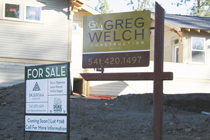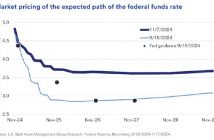
As the economy continues to grow both nationally and in Central Oregon, one thing on everyone’s mind is the current state of commercial and residential real estate. Optimism on the rise of activity in Central Oregon’s sales, vacation rentals, and building is abated by the cautiousness of those still reeling from 2008’s market crash.
“I see our market as stabilized,” says Becky Breeze, principal broker at Becky Breeze and Company Real Estate. “We no longer have the short sales next door selling for half the price.”
Krista Eastes of COLM Commercial Real Estate adds, “We are seeing a lot of skeptical buyers and sellers. But, those of us in the real estate business know that things are looking good from a rebounding and stabilizing perspective.”
The feeling of cautious optimism in the stabilization of our market is echoed throughout the real estate community. People are beginning to sell their own homes in other markets for a normal price, and then move here. In addition, low interest rates are helping first time buyers and homeowners looking to upgrade. Talk of building and sales activity by industry leaders is often followed by explanations on how today is different from the boom of 2004-2006.
“These days, people are using cash to buy properties, instead of no-money-down financing,” explains Brian Fratzke of Fratzke Commercial Real Estate Advisors.
The homebuyers looking to purchase either primary residences or investment properties have noticed a limited supply in all areas. The hottest properties in this seller’s market include anything under $220,000 in Bend and $185,000 in Redmond. As for specific areas, northeast Bend, and the continuously desirable NorthWest Crossing are the places reporting the most activity.
“Many places in Bend are hot right now,” emphasizes Breeze. “Around the hospital, in particular. The northeast side of Bend is booming, as well as near the airport and the businesses on Empire.”
Sean Stafford of Obsidian Real Estate Group concurs, “With all of the new parks and Pine Nursery Community Park, I think Northeast Bend is going to be big.”
For those investors looking for rental properties, the competition is fierce as demand is outpacing supply. The need for multi-family properties is raising the rental rates. With the OSU-Cascades campus on the horizon, the need is becoming even greater. And, while the City of Bend plays catchup to the market, there continues to be a shortage of land available to builders zoned for multi-family residences.
“The rental market is on fire,” says Stafford. “As soon as we post a listing, it’s gone. Since the prices are going up, they’re not pencilling as well for investors, but they’re still very hot.”
The Redmond rental market is experiencing the same increase in demand.
Diane Marr, of Redmond-based Marr Management, notes, “People are renting sight unseen here. Rents are rising and beginning to become out of reach for some people. There is no indication rents will stop increasing.”
Commercial real estate is as popular and, in some cases, even outpacing residential. A limited supply of buildings and correctly-zoned land combined with an increasingly high demand is creating a battle for all areas of commercial real estate.
From 2008 to 2011, a buyer’s and tenant’s market ruled the commercial landscape. 2012 saw a slow turn as the nation’s economy, including Central Oregon, began to rebound. Distressed properties were cleared out and people began to purchase the lower priced homes, under $300,000, in Central Oregon.
Business owners relocated to Bend because they could. Where we used to see high tech businesses move to Central Oregon, now we are seeing all types of companies relocate. A Pilates business, a keg supply business, and, of course, breweries all moved to town under the general feeling of, “I might as well live somewhere beautiful.”
Commercial Real Estate
Nowhere is commercial real estate’s popularity more illustrated than in light industrial buildings. Small business owners are searching for smaller square footage of space, with a roll-up door and an office. According to Fratzke, in 2012, Bend had 1.2 million square feet available, with 70 buildings for sale. This month, those numbers have decreased to 246,000 square feet of space, with three worthwhile buildings available.
Meanwhile, lease rates are making it harder to build for a profit. Bend is currently looking at an average of $.50 per square foot lease rate, and a $.77 per square foot build rate.
Retail space is becoming harder and harder to find as well. While there are still properties on the market, they usually are not suitable for the buyer’s needs. Poor parking, a high lease rate and incorrectly configured spaces are a few of the problems facing both property owners and businesses looking to lease.
The third sector, office space, is just beginning to improve over the last two months. The limitation of necessity in keeping business owners in offices caused the slower growth. For example, where industrial business owners need industrial space, office-based business owners can also work from home. Office spaces, ranging from 1,500 to 4000 square feet, are very hot right now.
Those real estate brokers and advisors who have been involved in Central Oregon’s real estate market maintain caution as the extreme cycles of the last 15 years weigh heavily on their minds.
“I am cautiously optimistic about the future,” says Stafford. “People tell me all the time how lucky we are to live here. It’s desirable.”
Many of the concerns centered around our real estate market ring true for most desirable markets across the country. Investors with cash are beginning to price first-time buyers out of the market. Local non-profits that were able to lease buildings for cheap as the owners benefitted from tax breaks, are being forced out as the benefits are being outpaced by lease rates. And, of course, the fear of another market crash understandably weighs on everyone’s mind.
The main concern for the future lies in the urban growth boundary expansion process. The City hopes to expand the UGB, or the imaginary line representing a 20-year supply of needed land drawn around the City, by 2018, which means buildings won’t get built until 2020, due to the necessary installation of services.
“I like the concept of the UGB,” explains Fratzke. “But, the problem is you have to go through the State to change the boundaries. It’s too infrequent of a review process.”
It seems as though every week Central Oregon’s desirability is reinforced as Bend gets named to another, “Best of,” list. Slowly, businesses want to move here for our climate, recreation possibilities and comparatively good economy.
“It puts Bend on the map,” says Nancy Dyer of Desert Pine Properties. “It helps the comprehensive real estate companies, the ones that do sales, rentals and vacation rentals, like ours.”
As Bend’s prices creep upward and problems with water, sewer and scarcity of land, home buyers and businesses will look to areas in Redmond, Prineville and La Pine to relocate.
But, as Breeze puts it, “If you build a good product, people will buy.”
Real Estate Sunriver
According to the first quarter report from Central Oregon Association of Realtors, the statistics for residential homes with less than an acre in Sunriver demonstrate a 4.76 percent decrease in the total number of homes sold, an increase of 9.89 percent in the average sales price of homes sold and a 7.18 percent increase in the average days on market when comparing the first quarter of 2014 to the first quarter of 2013. In addition, this comparison demonstrates a 100 percent decrease in the number of short sales and a 100 percent decrease in the number of bank owned sales.
Dan Cook, principal broker, regional sales leader at Berkshire Hathaway Home Services Northwest Real Estate said their inventory is slightly up but still good for this time of year with 121 active, 17 pending sales, with 22 sold so far this year compared to 22 sold during 2013.
“We are better than the first quarter of last year with an average sales price of $378,000 over the $367,000 of this time last year,” explained Cook. “Our average days on market are up but since we still have a good portion of the month left we look pretty good in comparison to this time last year.”
John Gibson and Ginny Kansas-Meszaros, principal brokers and certified residential specialists at Gibson Realty in Sunriver say the resort community has been slow to enter the dance of rising prices and falling inventory mirroring Bend and Redmond, but this past winter has set the stage for precisely that especially the opening of the Sunriver Homeowners Aquatic and Recreational Complex (SHARC). In 2012, this $18 million complex of tubing hills, water slides, indoor and outdoor pools/community center jumpstarted sales of homes in nearby villages as now these residences were near a major amenity.
The Sunriver Village after years of neglect is totally refreshed with new building and retailers. The 1970s boardwalk is gone, replaced by Northwest architecture and green spaces.
According to the National Association of Realtors, second home sales are up 30 percent year-over-year from 2012 to 2013 and counting for over one out of eight sales overall. Second homes make up 80 percent of the Sunriver housing stock and as Generation Xers are starting to buy homes being sold by baby boomers, a new set of owners are coming to town.
“The nationwide increase in second home sales is feeding this resort and rental community,” report Gibson and Kansas-Meszaros.
“In 2013, the median sales for Sunriver homes, according to the MLS of Central Oregon was $364,000.
“In the first three months of 2014, the median was $392,500 — an increase of 7.8 percent. More telling, the months of inventory dropped from a high of 30.2 in January 7, 2014 to March 2014’s level of 17.2.
“With the continued desirability of Central Oregon and the improving economy of Sunriver’s source markets of western Washington and Oregon, the next era of the Oregon community shall be bright.”





